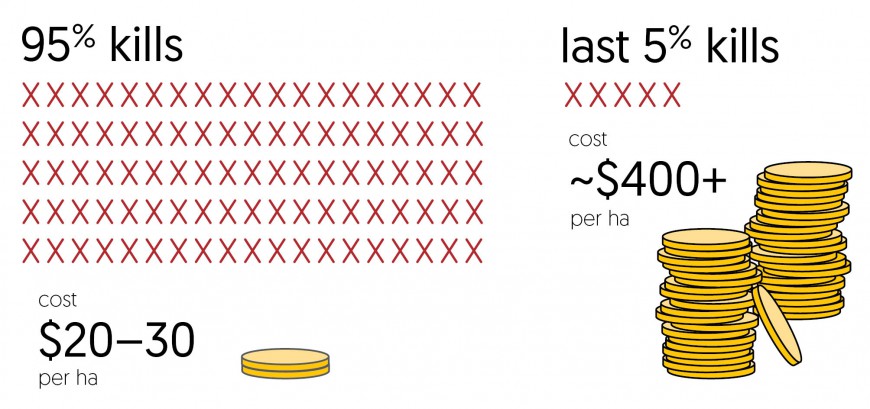Predator control routinely removes approximately 95% of a target population. However, New Zealand’s Predator Free 2050 initiative requires scientific breakthroughs to achieve 100% kills (i.e. eradication) of rats, mustelids and possums.
Although 95% kills typically cost $20–$30 per hectare, 100% kills cost over $400 per hectare. Pest eradication from Rangitoto and Motutapu Islands cost $1,200 per hectare. The prohibitive cost of eradicating the last 5% using current technology is a barrier to us achieving our Predator Free 2050 eradication goal.

As well as it being hugely expensive to remove the last 5% in a pest population, survivors remaining in an area with plentiful resources are likely to breed successfully and at close to their maximal rates. This, in turn, means that more money has to be spent on controlling them, and so the cycle of control continues.
The 5-year MBIE programme ‘Eradication Science’, which began in October 2019, is focused on the careful study of behaviours among pest populations to offer solutions to these problems. The fundamental questions addressed by the programme are as follows:
- what makes survivor individuals survive control?
- do they have predictable behavioural characteristics (why do these animals not take baits or enter traps when 95% of their species do)?
- how can we manipulate those behaviours using novel cues or combinations of cues to overcome survival behaviours?
The research now underway is a combination of many interdependent approaches:
- Animal behaviour: We will improve our understanding of survivor ‘personalities’ (behavioural traits) and how these differ from the ‘average’ individual in a population. This will allow us to use specific cues to alter the attractiveness of sites/traps to exploit those motivations.
- Identification and development of cues: The extent to which a pest responds to a cue is a trade-off between the perceived risk, the value of the reward, and the traits of the individual. We will identify and develop a range of cues that deliberately alter the target’s perception of risk and reward.
- Working with mātauranga Māori on animal behaviour: We will work with our iwi/imi and hapū partners to identify mātauranga associated with traditional trapping and luring, such as the use of sound lures or recognition of cyclical or seasonal variations in animal behaviour.
AI in pest control: Artificial intelligence, including the use of image recognition to identify pest species, has huge potential to facilitate targeted pest control via smart traps.
Our research will help land managers to achieve full eradication cost-effectively. Our collaboration with Māori and Moriori partners will also ensure our research responds to their priorities – a first for predator tools research in New Zealand – and that any approaches we develop are culturally relevant and appropriate for use on the whenua.
Key contact

